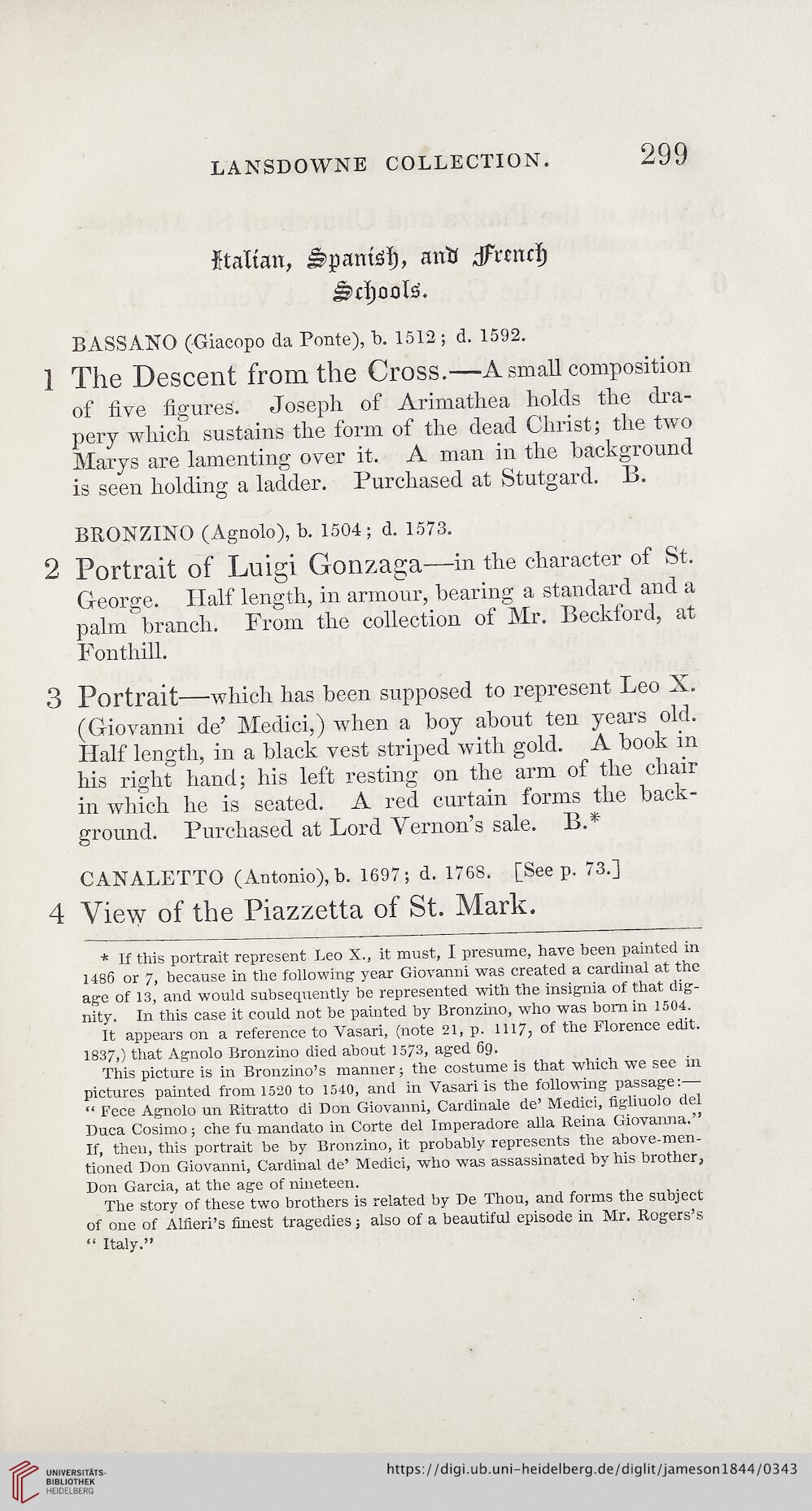LANSDOWNE COLLECTION.
299
Italian, ^partial), anti dFrencf)
JjdjooL.
BASSANO (Giacopo da Ponte), b. 1512; d. 1592.
1 The Descent from the Cross.—A small composition
of five figures. Joseph of Arimathea holds the dra-
pery which sustains the form of the dead Christ; the two
Marys are lamenting over it. A man in the background
is seen holding a ladder. Purchased at Stutgard. B.
BRONZINO (Agnolo), b. 1504; d. 1573.
2 Portrait of Luigi Gonzaga—in the character of St.
George. Half length, in armour, bearing a standard and a
palm branch. From the collection of Mr. Beckford, at
Fonthill.
3 Portrait—which has been supposed to represent Leo X.
(Giovanni de’ Medici,) when a boy about ten years old.
Half length, in a black vest striped with gold. A book in
his right hand; his left resting on the arm of the chair
in which he is seated. A red curtain forms the back-
ground. Purchased at Lord Vernon’s sale. B.*
CANALETTO (Antonio), b. 1697; d. 1768. [Seep. 73.]
4 View of the Piazzetta of St. Mark.
* If this portrait represent Leo X., it must, I presume, have been painted in
I486 or 7, because in the following year Giovanni was created a cardinal at the
age of 13, and would subsequently be represented with the insignia of that dig-
nity. In this case it could not be painted by Bronzino, who was born in 1504.
It appears on a reference to Vasari, (note 21, p. 1117, of the Florence edit.
1837,) that Agnolo Bronzino died about 157-3, aged 6g.
This picture is in Bronzino’s manner; the costume is that which we see in
pictures painted from 1520 to 1540, and in Vasari is the following passage:—
“ Fece Agnolo un Ritratto di Don Giovanni, Cardinale de’ Medici, figliuolo del
Duca Cosimo; che fu mandate in Corte del Imperadore alia Reina Giovanna.”
If, then, this portrait be by Bronzino, it probably represents the above-men-
tioned Don Giovanni, Cardinal de’ Medici, who was assassinated by his brother,
Don Garcia, at the age of nineteen.
The story of these two brothers is related by De Thou, and forms the subject
of one of Alfieri’s finest tragedies; also of a beautiful episode in Mr. Rogers’s
“ Italy.”
299
Italian, ^partial), anti dFrencf)
JjdjooL.
BASSANO (Giacopo da Ponte), b. 1512; d. 1592.
1 The Descent from the Cross.—A small composition
of five figures. Joseph of Arimathea holds the dra-
pery which sustains the form of the dead Christ; the two
Marys are lamenting over it. A man in the background
is seen holding a ladder. Purchased at Stutgard. B.
BRONZINO (Agnolo), b. 1504; d. 1573.
2 Portrait of Luigi Gonzaga—in the character of St.
George. Half length, in armour, bearing a standard and a
palm branch. From the collection of Mr. Beckford, at
Fonthill.
3 Portrait—which has been supposed to represent Leo X.
(Giovanni de’ Medici,) when a boy about ten years old.
Half length, in a black vest striped with gold. A book in
his right hand; his left resting on the arm of the chair
in which he is seated. A red curtain forms the back-
ground. Purchased at Lord Vernon’s sale. B.*
CANALETTO (Antonio), b. 1697; d. 1768. [Seep. 73.]
4 View of the Piazzetta of St. Mark.
* If this portrait represent Leo X., it must, I presume, have been painted in
I486 or 7, because in the following year Giovanni was created a cardinal at the
age of 13, and would subsequently be represented with the insignia of that dig-
nity. In this case it could not be painted by Bronzino, who was born in 1504.
It appears on a reference to Vasari, (note 21, p. 1117, of the Florence edit.
1837,) that Agnolo Bronzino died about 157-3, aged 6g.
This picture is in Bronzino’s manner; the costume is that which we see in
pictures painted from 1520 to 1540, and in Vasari is the following passage:—
“ Fece Agnolo un Ritratto di Don Giovanni, Cardinale de’ Medici, figliuolo del
Duca Cosimo; che fu mandate in Corte del Imperadore alia Reina Giovanna.”
If, then, this portrait be by Bronzino, it probably represents the above-men-
tioned Don Giovanni, Cardinal de’ Medici, who was assassinated by his brother,
Don Garcia, at the age of nineteen.
The story of these two brothers is related by De Thou, and forms the subject
of one of Alfieri’s finest tragedies; also of a beautiful episode in Mr. Rogers’s
“ Italy.”




